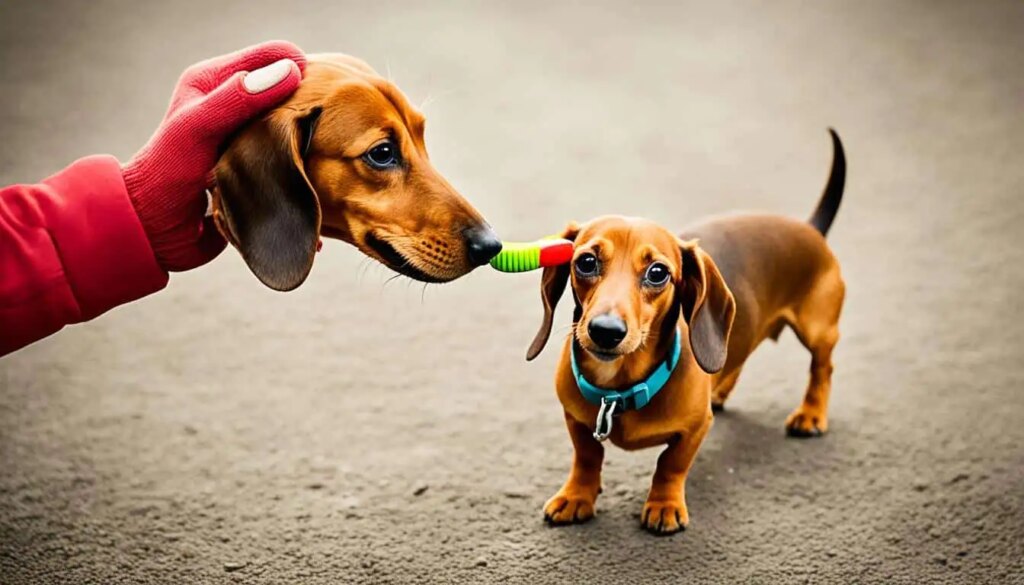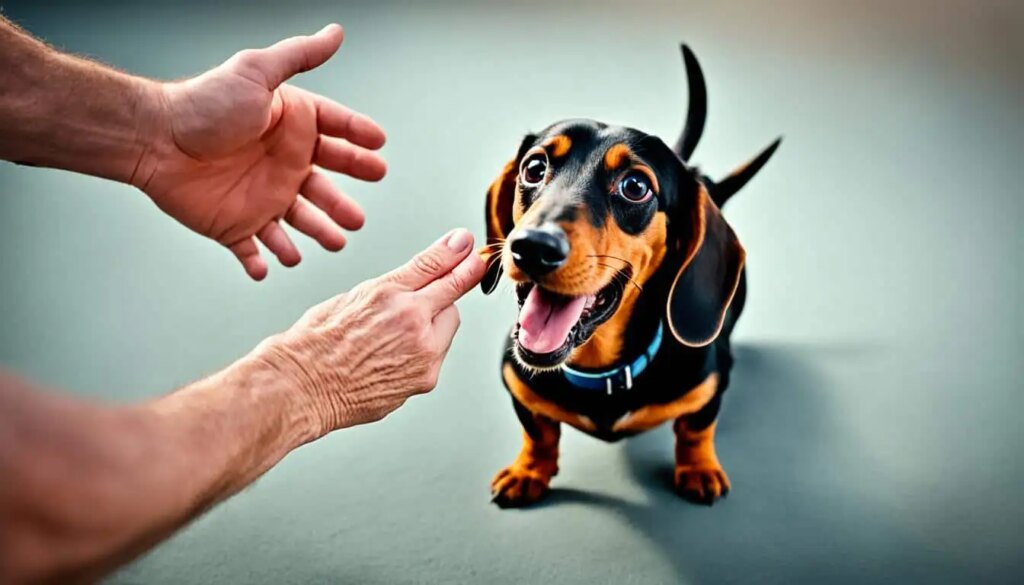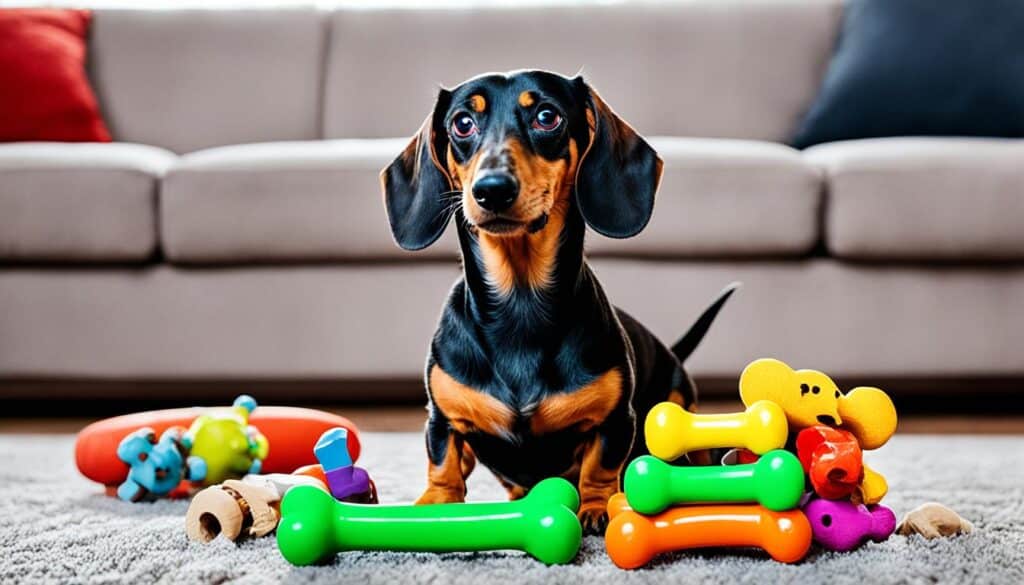As a proud owner of a Dachshund, you know the joy and love they bring into your life. But let’s be honest, dealing with their biting behavior can be challenging and, at times, downright painful. I’ve been through it too, and I understand the frustration it can cause. That’s why I’m here to provide you with effective tips to help stop your Dachshund from biting.
Dachshunds have a natural instinct to nip and bite, rooted in their breed’s hunting history. Whether it’s teething or playful behavior, understanding the cause is key to addressing this issue. By implementing targeted training techniques, redirecting their focus, and using positive reinforcement, you can establish boundaries and encourage appropriate behavior in your fur baby.
Now, let’s dive into the strategies that will help you put an end to your Dachshund’s biting habits and create a harmonious environment for both of you.
Understanding Dachshund Biting Behavior
Dachshunds have a natural tendency to bite and nip, which stems from their breed history as hunters. Additionally, puppies may exhibit biting behavior during teething or playtime. In order to effectively address this behavior, it is important to understand the root causes behind Dachshund biting.
By recognizing the triggers and underlying reasons for their biting, you can develop targeted solutions to discourage this behavior and encourage positive interactions with your Dachshund. Whether it’s teething or playful nipping, addressing the specific cause is crucial for implementing appropriate training techniques.
Table: Common Causes of Dachshund Biting Behavior
| Cause | Description |
|---|---|
| Teething | Dachshund puppies may bite more frequently during the teething process as a way to relieve discomfort. |
| Playfulness | Some Dachshunds may resort to nipping or biting as part of their play behavior, especially during interactive play sessions. |
| Fear or Anxiety | Dachshunds may bite when they feel threatened or afraid, as it is their natural instinct for self-defense. |
| Seeking Attention | Dachshunds may resort to biting as a means of seeking attention from their owners. |
To effectively address Dachshund biting behavior, it’s crucial to implement targeted training techniques that redirect their instincts and teach them appropriate behaviors. Throughout the rest of this article, we will explore various methods and strategies to help you tackle Dachshund biting behavior and establish a positive relationship with your pet.
How can I stop my Dachshund from biting?
To stop your Dachshund from biting, it’s important to understand the underlying causes and implement effective strategies. By identifying trigger points and creating a consistent response plan, you can redirect their biting behavior and encourage positive interactions.
Identifying Trigger Points
Understanding the reasons behind your Dachshund’s biting behavior is key to addressing it effectively. Biting can be triggered by fear, anxiety, teething, or the desire for attention. By recognizing these triggers, you can develop targeted solutions to discourage biting. For example, if your Dachshund is biting due to teething, providing appropriate chew toys can redirect their focus and satisfy their chewing needs.
Creating a Consistent Response Plan
Consistency is crucial in teaching your Dachshund that biting is unacceptable. When your Dachshund begins to bite, immediately redirect their attention to an alternative behavior, such as playing with a chew toy or engaging in interactive activities. Consistently reinforce this redirection and reward them for choosing the appropriate behavior. Over time, your Dachshund will learn that biting is not rewarded, and alternative actions are more desirable.
Redirecting your Dachshund’s biting behavior requires patience and persistence. By actively addressing the triggers and consistently redirecting their attention, you can guide them towards more appropriate behaviors.
Redirecting Dachshund Biting Behavior
Redirecting your Dachshund’s biting behavior is crucial for their well-being and the safety of those around them. By understanding the root cause of their biting, you can implement targeted solutions and training techniques to redirect their tendencies. Here are some effective strategies to help you redirect your Dachshund’s biting behavior:
- Understand the Cause: Determine if your Dachshund is biting due to teething or playful nipping. Addressing the underlying cause will help you develop appropriate solutions.
- Redirect & Reward: Provide your Dachshund with safe chew toys whenever they start nipping. Encourage them to play with the toys instead of using their mouth on your hands or belongings. Reward them with praise or treats when they engage with the toys.
- The “Ouch” Method: Mimic puppy playtime yelps by letting out a firm, high-pitched “ouch” when your Dachshund bites too hard. This method helps them understand that biting leads to the end of playtime or attention.
- Limit Playtime after Biting: Immediately end playtime or attention whenever your Dachshund bites. This teaches them that biting has consequences and helps establish boundaries.
- Seek Professional Help: If your Dachshund’s biting behavior persists or becomes aggressive, consult a professional trainer or behaviorist who specializes in Dachshund behavior. They can provide expert guidance and support to address complex biting issues effectively.
Redirecting your Dachshund’s biting behavior requires patience, consistency, and positive reinforcement. By offering appropriate chew toys, implementing the “Ouch” method, and seeking professional help if necessary, you can redirect their biting tendencies and promote a safe and harmonious environment for everyone.

Positive Reinforcement Training Techniques
Positive reinforcement training techniques can be highly effective in stopping Dachshund biting. By using rewards and incentives, you can motivate your Dachshund to exhibit desired behaviors and discourage biting. This approach focuses on reinforcing positive behavior rather than punishing unwanted behavior, creating a more harmonious training experience for both you and your furry friend.
Establishing Reward Systems
One key aspect of positive reinforcement training is establishing reward systems. This involves identifying behaviors that you want to encourage in your Dachshund and determining appropriate rewards for those behaviors. Rewards can include verbal praise, petting, or small treats. By consistently rewarding desired behavior, you reinforce the idea that good behavior is rewarded, increasing the likelihood that your Dachshund will repeat those behaviors.
Using Treats Effectively
Treats can be a valuable tool in positive reinforcement training. When using treats, it’s important to choose small, bite-sized treats that your Dachshund finds enticing. These treats should be reserved exclusively for training sessions to ensure they maintain their value. When your Dachshund exhibits the desired behavior, offer a treat immediately and provide positive reinforcement through verbal praise and petting. This reinforces the association between the behavior and the reward, making it more likely that your Dachshund will continue to exhibit the desired behavior.
Appropriate Toys to Deter Dachshund Chewing
Providing appropriate toys is essential for deterring Dachshund chewing and redirecting their biting behavior. Dachshunds have a natural urge to chew, and it’s important to offer them toys that are safe, durable, and specifically designed for their needs.
When selecting chew toys for your Dachshund, consider the following:
- Safety: Choose toys made of non-toxic materials that won’t break apart easily.
- Durability: Dachshunds have strong jaws, so opt for toys that can withstand their chewing habits.
- Size: Select toys that are appropriate for your Dachshund’s size to prevent choking hazards.
- Texture: Dogs have preferences for different textures, so offer a variety of toys with different surfaces.
By providing a range of chew toys and rotating them regularly, you can keep your Dachshund engaged and prevent boredom. This will help redirect their focus onto appropriate chewing options and discourage them from biting household items.
Remember to always supervise your Dachshund while they’re playing with chew toys, and remove any damaged or broken toys immediately to prevent ingestion of small parts.
Implementing the “Ouch” Method
When it comes to addressing dachshund biting, implementing the “Ouch” method can be an effective technique. This method works by mimicking puppy playtime yelps, signaling to your dachshund that their biting behavior is unwanted.
How the “Ouch” Method Works
When your dachshund bites too hard, let out a firm and high-pitched “ouch” to communicate that their behavior is undesirable. This action replicates how puppies react when they accidentally hurt each other during play. By doing so, you’re teaching your dachshund that biting leads to the end of playtime or attention.

Timing and Consistency in the “Ouch” Method
Timing and consistency are critical when implementing the “Ouch” method. Make sure to deliver the “ouch” immediately after your dachshund bites too hard. This helps them link their biting behavior with the consequences. Additionally, be consistent in your response each time your dachshund bites. This will reinforce the message and help them understand that biting is unacceptable.
Learning to Limit Playtime Effectively
Limiting playtime is an important aspect of dachshund training to stop biting behavior. By setting clear boundaries and ending play sessions when biting occurs, you can teach your dachshund that biting leads to the end of fun. Consistency and persistence in enforcing these limits are key to reinforcing the message and encouraging appropriate behavior during playtime.
Understanding the cause:
- Is it puppy teething or playful nipping?
- Address the root cause for targeted solutions
Redirect & Reward:
- Offer safe chew toys when they start nipping
- Reward playing with toys instead of hands
The “Ouch” Method:
- Mimic puppy playtime yelps with a firm, high-pitched “ouch”
- Signal unwanted behavior
Limit Playtime after Biting:
- End playtime immediately after biting
- Teach consequences
Seek Professional Help:
- If biting persists, consult a professional
When to Seek Professional Help for Dachshund Behavior
In some cases, professional help may be necessary to address persistent or aggressive biting behaviors in Dachshunds. While most biting issues can be resolved with training and redirection techniques, there are specific signs that indicate it’s time to seek professional guidance. Recognizing these signs and finding the right trainer or behaviorist who specializes in Dachshund behavior can provide the expertise and support needed to address complex biting issues effectively.
Signs That It’s Time for Professional Help
Not all Dachshund biting behavior requires professional intervention. However, if you notice any of the following signs, it’s essential to consult a professional:
- Escalating biting incidents that do not respond to training methods
- Aggressive behavior, including growling, snarling, or lunging
- Biting accompanied by signs of fear or anxiety
- Biting that causes injury to humans or other animals
- Biting that occurs in multiple contexts or with varying triggers
- Biting that persists beyond the puppy teething stage
Finding the Right Trainer or Behaviorist
When seeking professional help for Dachshund biting behavior, finding the right trainer or behaviorist is crucial. Consider the following factors to ensure you choose a professional who can effectively address your Dachshund’s biting issues:
- Experience and expertise in working with Dachshunds
- Positive reinforcement training methods
- Understanding of Dachshund behavior and breed-specific tendencies
- Ability to tailor training techniques to address biting issues
- Positive reputation and testimonials from satisfied clients
- Clear communication and ability to work with both you and your Dachshund
Take the time to research and interview potential trainers or behaviorists to ensure they align with your goals and expectations. Consulting a professional can provide the guidance and support needed to resolve complex biting behaviors and create a safe environment for both you and your Dachshund.
Conclusion
In conclusion, stopping Dachshund biting requires a combination of understanding their behavior, redirecting their instincts, and implementing consistent training techniques. By addressing the root cause of the biting, whether it be puppy teething or playful nipping, you can develop targeted solutions to discourage this behavior.
Redirecting and rewarding your Dachshund is an essential part of the training process. Offering safe chew toys whenever they start nipping and rewarding them for playing with those toys instead of your hands helps to redirect their biting tendencies.
The “Ouch” method can be a powerful tool in communicating boundaries to your Dachshund. By letting out a firm, high-pitched “ouch” when they bite too hard, you can mimic puppy playtime yelps and signal that their behavior is unwanted.
It’s important to limit playtime immediately after biting occurs. Ending play sessions when biting happens teaches your Dachshund the consequences of their actions and reinforces the message that biting leads to the end of fun.
If biting behaviors persist or become aggressive, it may be necessary to seek professional help. Consulting a Dachshund trainer or behaviorist who specializes in addressing biting issues can provide the expertise and support needed to effectively resolve the problem.
Remember, consistency and patience are key throughout the training process. It may take time for your Dachshund to learn and adapt to the new behaviors. With dedication, the right approach, and a safe and enjoyable environment, you can successfully stop your Dachshund from biting and foster a healthy and harmonious bond.
